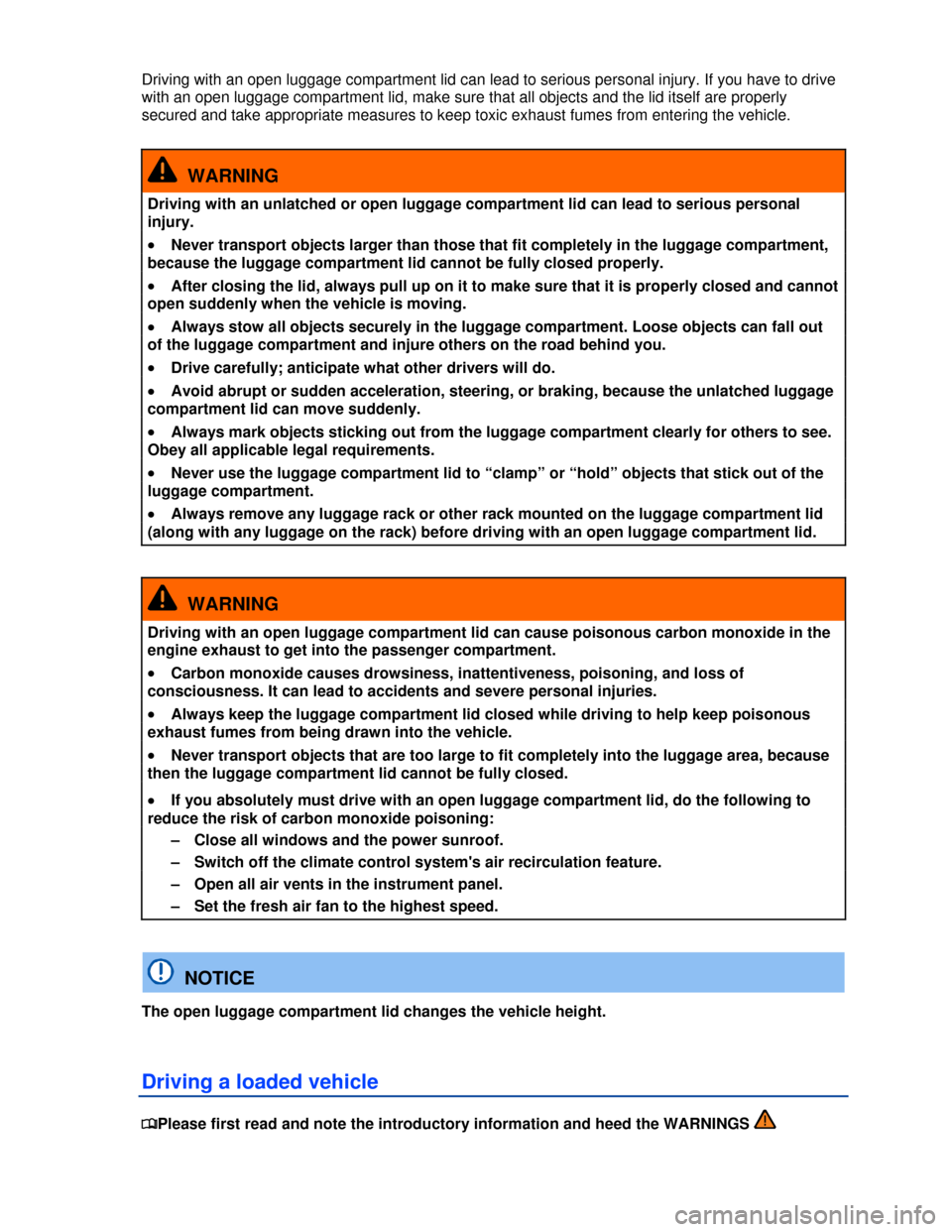2013 VOLKSWAGEN PASSAT CC ABS
[x] Cancel search: ABSPage 126 of 353

Driving with an open luggage compartment lid can lead to serious personal injury. If you have to drive
with an open luggage compartment lid, make sure that all objects and the lid itself are properly
secured and take appropriate measures to keep toxic exhaust fumes from entering the vehicle.
WARNING
Driving with an unlatched or open luggage compartment lid can lead to serious personal
injury.
�x Never transport objects larger than those that fit completely in the luggage compartment,
because the luggage compartment lid cannot be fully closed properly.
�x After closing the lid, always pull up on it to make sure that it is properly closed and cannot
open suddenly when the vehicle is moving.
�x Always stow all objects securely in the luggage compartment. Loose objects can fall out
of the luggage compartment and injure others on the road behind you.
�x Drive carefully; anticipate what other drivers will do.
�x Avoid abrupt or sudden acceleration, steering, or braking, because the unlatched luggage
compartment lid can move suddenly.
�x Always mark objects sticking out from the luggage compartment clearly for others to see.
Obey all applicable legal requirements.
�x Never use the luggage compartment lid to “clamp” or “hold” objects that stick out of the
luggage compartment.
�x Always remove any luggage rack or other rack mounted on the luggage compartment lid
(along with any luggage on the rack) before driving with an open luggage compartment lid.
WARNING
Driving with an open luggage compartment lid can cause poisonous carbon monoxide in the
engine exhaust to get into the passenger compartment.
�x Carbon monoxide causes drowsiness, inattentiveness, poisoning, and loss of
consciousness. It can lead to accidents and severe personal injuries.
�x Always keep the luggage compartment lid closed while driving to help keep poisonous
exhaust fumes from being drawn into the vehicle.
�x Never transport objects that are too large to fit completely into the luggage area, because
then the luggage compartment lid cannot be fully closed.
�x If you absolutely must drive with an open luggage compartment lid, do the following to
reduce the risk of carbon monoxide poisoning:
– Close all windows and the power sunroof.
– Switch off the climate control system's air recirculation feature.
– Open all air vents in the instrument panel.
– Set the fresh air fan to the highest speed.
NOTICE
The open luggage compartment lid changes the vehicle height.
Driving a loaded vehicle
�
Page 195 of 353

causes you to run off the road before ESC can provide any assistance, you may not experience the
benefits of ESC.
ESC includes and/or works together with the ABS, BAS, ASR, EDL, and XDL systems (see below).
ESC is switched on all the time. In certain situations when you need less traction or additional traction
cannot be achieved, you can switch off ASR by pressing the �m button ⇒ fig. 122. Be sure to switch
ASR on again when you no longer need less traction.
Anti-Lock Brake System (ABS)
ABS helps to keep the wheels from locking up and helps to maintain the driver's ability to steer and
control the vehicle. This means the vehicle is less likely to skid, even during hard braking:
�x Push the brake pedal down hard and hold it there. Don't take your foot off the pedal or reduce the
force on the pedal!
�x Do not “pump” the brake pedal or let up on it!
�x Steer the vehicle while pushing down hard on the brake pedal.
�x ABS stops working if you release or let up on the brake.
When ABS is doing its job, you will notice a slight vibration through the brake pedal and hear a
noise. ABS cannot shorten the stopping distance under all conditions. The stopping distance may
even be longer, for instance, when driving on gravel or on newly fallen snow covering an icy or
slippery surface.
Brake Assist (BAS)
The Brake Assist System can help to reduce stopping distances. If you press the brake pedal very
quickly, BAS detects an emergency situation. It then very quickly builds up full brake system pressure,
maximizing braking power and reducing the stopping distance. This way, ABS can be activated more
quickly and efficiently.
Do not reduce pressure on the brake pedal! BAS switches off automatically as soon as you release or
let up on the brake.
Anti-Slip Regulation (ASR)
ASR reduces engine power directed to spinning wheels and adjusts power to the road conditions.
Even under poor road conditions, ASR can make it easier to get moving, accelerate, and climb hills.
ASR can be switched on or off manually
Electronic Differential Lock (EDL and XDL)
EDL is applied during regular straight-line acceleration. EDL gently brakes a drive wheel that has lost
traction (spinning) and redirects the drive force to other drive wheels. In extreme cases, EDL
automatically switches off to keep the brake from overheating. As soon as the brake has cooled down,
EDL automatically switches on again.
XDL is an extension of the Electronic Differential Lock system. XDL does not react to drive wheel
slippage when driving straight ahead. Instead, XDL detects slippage of the inside front wheel during
fast cornering. XDL applies enough brake pressure to this wheel in order to stop the slippage. This
improves traction, which helps the vehicle stay on track.
Page 196 of 353

WARNING
Driving fast on icy, slippery, or wet roads can lead to a loss of control and result in serious
personal injury for you and your passengers.
�x Always adjust your speed and driving style to road, traffic, weather, and visibility
conditions. Never let the additional safety that ESC, ABS, BAS, ASR, and EDL can provide
tempt you into taking extra risks.
�x Braking assistance systems cannot overcome the laws of physics and always prevent
loss of vehicle control. Slippery and wet roads are still dangerous even with ESC and the
other systems!
�x Driving too fast on wet roads can cause the wheels to lose contact with the road and
“hydroplane.” A vehicle that has lost road contact cannot be braked, steered, or controlled.
�x These systems cannot reduce the risk of accident, for example if you drive too fast for
conditions or if you do not keep your distance from the vehicle in front of you.
�x Although these systems are very effective and can help you control the vehicle in many
difficult situations, always remember that your vehicle handling control is limited by tire
traction.
�x When accelerating on a slippery surface, for example on ice and snow, depress the
accelerator carefully. Even with these systems, the wheels may start to spin, leading to a loss
of vehicle control.
WARNING
The effectiveness of ESC can be significantly reduced if other components and systems that
affect vehicle dynamics, including but not limited to brakes, tires, and other systems
mentioned above, are not properly maintained or functioning.
�x Always remember that vehicle alterations or modifications can affect the functioning of
the ABS, BAS, ASR, EDL, and ESC systems.
�x Changing the vehicle suspension or using an unapproved tire/wheel combination can
change the way the ABS, BAS, ASR, EDL, and ESC systems work and reduce their
effectiveness.
�x The effectiveness of ESC is also determined by the tires fitted
All 4 wheels must be equipped with identical tires in order for ESC and ASR to work properly.
Differences in the tread circumference of the tires can cause the system to reduce the engine power
when it is not expected.
If ABS is not working, ESC, ASR, and EDL will also not work.
You may hear noises when these systems are active.
Page 226 of 353

Your vehicle's Tire Pressure Monitoring System (TPMS) uses the Anti-lock Brake System (ABS)
sensors to indirectly check the tire pressure of all 4 tires while you are driving. The sensors monitor the
tread circumference (rolling circumference) and vibration characteristics of the individual tires. TPMS
warns if there is a significant loss of pressure in one or more tires while the vehicle is moving.
Pressure loss is signaled by the indicator light Ç (described below) as well as by text warnings in the
instrument cluster display if your vehicle has this display (Multi-Function Indicator- MFI).
The original benchmark pressure is the recommended maximum load cold tire inflation pressure for
the tires that come with your vehicle. This pressure is listed on the tire pressure label on the driver
door jamb. After adjusting the tire pressures in all 4 tires, you must confirm and store the new cold
inflation pressures using the Settings menu in the instrument cluster , which changes the
benchmark pressure to match the current pressure of the tires on your vehicle.
Recalibrating the TPMS to reset the benchmark cold tire inflation pressure is explained below
More information:
�x Volkswagen Information System
�x Transporting
�x Braking, stopping and parking
�x Exterior care and cleaning
�x Tires and wheels
�x Parts, accessories, repairs and modifications
�x Consumer information
Page 237 of 353

�x After any tire on your vehicle is changed and replaced by another tire, even if the replacement tire
is the same type and is inflated to the same pressure as the tire it replaced.
�x After adjusting the tire pressure of any tire on the vehicle to its correct cold tire inflation pressure,
either by putting air in one or more tires or by letting air out. Do this even though air was only added
(or let out) to bring the tire to the inflation pressure it should have had all along.
�x After rotating the front and rear wheels
�x After mounting the compact spare tire.
WARNING
Incorrect recalibration can cause the TPMS to give false warnings or to give no warning
despite dangerously low tire pressure. Make certain the tire inflation pressure of all tires is
correct before resetting the system.
WARNING
Incorrect tire pressure can cause sudden tire failure, loss of vehicle control and serious
personal injury.
�x Always check and correct air pressure in all 4 tires, particularly after changing,
exchanging, or repairing tires.
�x After that, always make sure that all 4 tires are inflated to the correct tire pressure for the
tires installed on the vehicle. Then reset the system so that it can monitor the correct tire
pressure.
�x See the tire pressure label and the Owner's Literature for recommended cold tire inflation
pressure and other important information.
�x When replacing tires or wheel rims, always read and heed all of the information and
WARNINGS
�x The Tire Pressure Monitoring System must be recalibrated whenever you remove and
remount or change any wheel or tire on the vehicle, even if the reinstalled or replacement
wheels and tires are identical to those that were removed and even if the tire pressure does
not change.
The Tire Pressure Monitoring System stops working if there is an ESC/ABS malfunction.
After a low tire pressure warning, the vehicle must stand and must not be driven for at least one
minute before the new benchmark tire pressures can be stored.
Page 352 of 353

Abbreviations
Abbreviation Meaning
5S man 5-speed manual transmission
6S auto 6-speed automatic transmission
6S man 6-speed manual transmission
ABS Anti-lock Brake System
AFS Adaptive Front Lighting System
AKI Anti-Knock Index
ANSI American National Standards Institute
ASR Anti-Slip Regulation
ATA Anti-Theft Alarm system
BAS Brake Assist System
ccm Cubic centimeter – metric unit of measure for engine displacement
CCS Cruise Control System
CID Cubic inch displacement – unit of measure for engine displacement
cm Centimeter – metric unit of measure for length
CO2 Carbon dioxide
DIN Deutsches Institut für Normung (German Institute for Standardization)
DRL Daytime Running Lights
DSG® Direct Shift Gearbox automatic transmission
EDL Electronic Differential Lock
EN European Norm
EPC Engine control (Electronic Power Control)
ESC Electronic Stability Control
g/km Generated carbon monoxide amount in grams per kilometer driven
GAWR Gross Axle Weight Rating
GVWR Gross Vehicle Weight Rating
HID High Intensity Discharge headlights (Xenon)
hp Horsepower – unit of measure for engine power
kg Kilogram – metric unit of measure for weight
kN Kilonewton – a unit of measure for force
kp Kilopond – unit of measure for force
kPa Kilopascal – unit of measure for tire pressure
kW Kilowatt – engine rating
LED Light Emitting Diode
m Meter – metric unit of measure for length